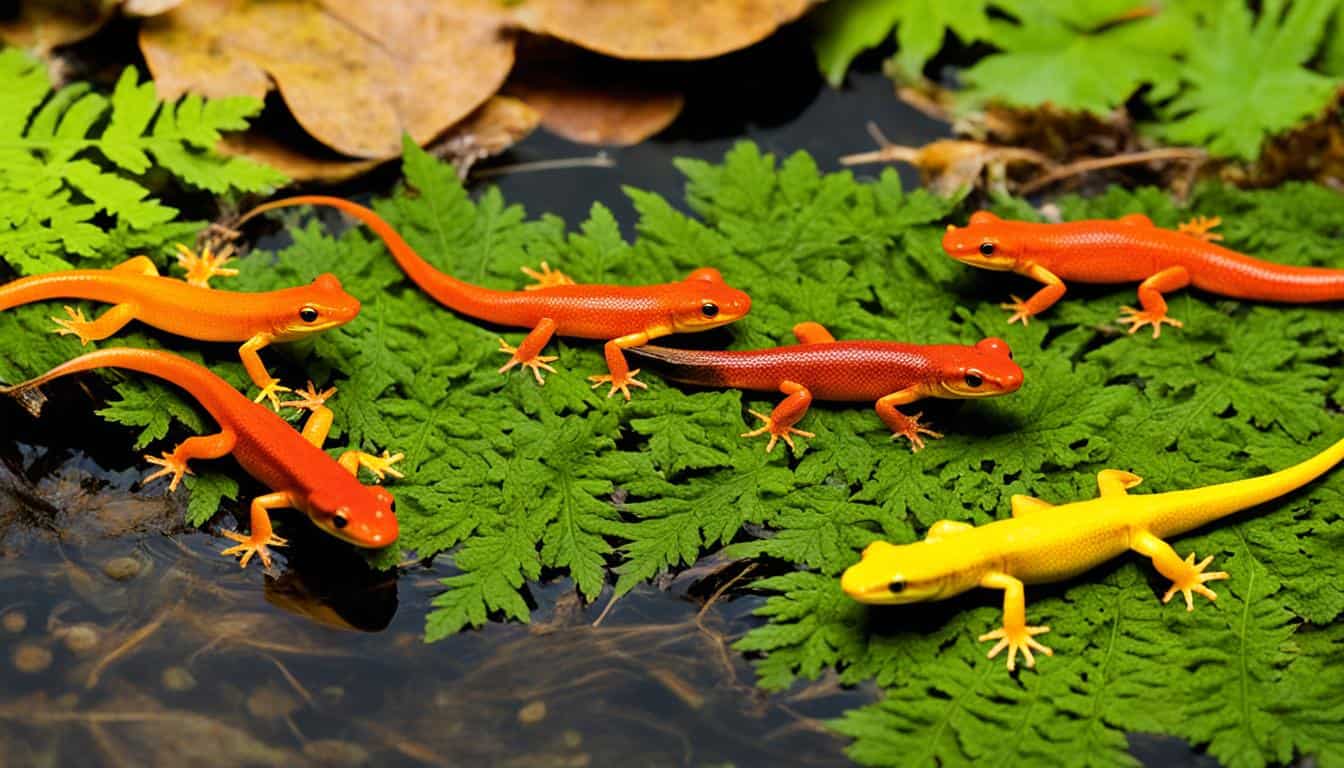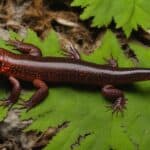Differentiating between newt species in the USA requires exploring their varied backgrounds. Newts are often confused with lizards. But, they lack reptilian traits like scales and claws. They are carnivores and love living in water, changing a lot in their life cycles.
To spot various newt species in the USA, look at their colors, markings, and where they live. Knowing these details helps in telling them apart.
Overview of Newt Species in the USA
The American newt species guide is a detailed look at different newt families and features found in the USA. This guide helps us correctly identify newt species across the country. It’s important for anyone interested in newts to be able to tell them apart.
Major Families
American newts are part of various families, with about 350 types of salamanders existing throughout the Americas and in the northern temperate areas. In the USA, there are five main families that have 112 species. They are known for being secretive and eating meat.
General Characteristics
Newts have varied ways of finding mates and reproducing, often showing external gills when they are young. During their growth, they change into forms that live in water or on land, depending on where they are needed. Their actions mainly aim to locate good places to live and reproduce.
Differences Between Newts and Salamanders
Understanding newts and salamanders means looking closely at their skin and how they live. Although they are both from the order Urodela, they have clear differences. These differences are key to telling them apart.
Newts have rough skin that’s perfect for living partly in water. Salamanders, on the other hand, have a slimy skin that works well on land. You’ll also find that newts don’t have the same grooves on their skin that salamanders do.
When newts and salamanders are ready to mate, their behaviors show big differences. Newts especially change physically, showing swollen vents and keeled tails. These indicate it’s their turn to reproduce. On the other side, salamanders’ changes are not as clear.
| Feature | Newts | Salamanders |
|---|---|---|
| Skin Texture | Rough | Slimy |
| Coastal Grooves | Indistinct | Prominent |
| Breeding Adaptations | Swollen vents, keeled tails | Less pronounced |
Identifying Eastern Newts vs. Western Newts
Learning to tell Eastern and Western newts apart helps us see the beautiful variety in America’s wildlife. These newts look different, act differently, and live in various places around the country.
Physical Traits
Eastern and Western newts have noticeable physical differences. Eastern newts are often brightly colored, especially when they’re young. In contrast, Western newts have more natural, earthy colors.
When it comes to skin, Eastern newts have a sleek look in their water-dwelling stage. Western newts, on the other hand, have a rougher, granular skin no matter where they are in their life cycle. This can help spot which is which.
Behavioral Differences
The way Eastern and Western newts behave is a big clue to their identity. Eastern newts love the water, often living in ponds and streams. In comparison, Western newts prefer land, especially when they’re not breeding.
Knowing these behaviors makes it easier to figure out which species you’re looking at. It’s part of the fun of recognizing these creatures in the wild.
Geographical Distribution
The where they live also helps in newt identification. Eastern newts call the east of the USA home, from Maine down to Florida. Western newts, however, are found on the west coast, from California all the way up to Washington state.
This difference in location is a major clue in telling the two types apart. It shows how they’re both uniquely adapted to their own environments.
| Aspect | Eastern Newts | Western Newts |
|---|---|---|
| Coloration | Bright, vivid during eft stage | Earth-toned throughout life |
| Skin Texture | Smooth in adult stage | Rough and granular |
| Habitat | Primarily aquatic | Mainly terrestrial outside breeding season |
| Geographical Distribution | Eastern USA (Maine to Florida) | Western USA (California to Washington) |
Taricha Genus: Western Newts
The Taricha genus is full of unique newt species like the California Newt, Sierra Newt, and more. These newts look a bit different depending on where they live. But they all have their special features.
To really tell these Taricha genus newts apart, you need to know what makes each one special.
California Newt
The California Newt lives in California by the ocean and in the Sierra Nevada mountains. You can spot it by its orange-brown to dark brown skin. It has a bumpy skin and an orange belly. Plus, its eyes stick out a lot.
Sierra Newt
The Sierra Newt looks a lot like the California Newt but is found in a bigger area. It has lighter colors and its skin is not as bumpy. These differences help tell it apart within the Taricha genus.
Red-bellied Newt
The Red-bellied Newt calls northern California’s coast home. It’s known for its red belly and greenish-brown back. Its skin is quite smooth, making it stand out from other newts.
Rough-skinned Newt
The Rough-skinned Newt lives from California to British Columbia. It’s easy to identify by its rough, dark skin. It also carries a powerful poison that protects it from predators and gives it a broader area to live. Understanding these unique characteristics can help when telling newts apart, particularly the California newt.
Here is a detailed comparison to aid in identification:
| Newt Species | Main Habitats | Key Identification Traits | Notable Features |
|---|---|---|---|
| California Newt | California coastal and Sierra Nevada streams | Orange-brown to dark brown skin, warty texture, bright orange underbelly | Protruding eyes |
| Sierra Newt | Western slopes of Sierra Nevada | Lighter coloration than California Newt, less warty | More extensive range and habitat preference |
| Red-bellied Newt | Coastal streams in northern California | Bright red underbelly, olive-brown upper body, smoother skin | Native to restricted regions |
| Rough-skinned Newt | Areas from California to British Columbia | Rough-textured skin, dark brown hue | Toxicity for defense, broader geographical range |
Notophthalmus Genus: Eastern Newts
The Notophthalmus genus showcases bright Eastern newts. This part looks at key species in the genus and their interesting life cycles.
Main Species
In the Notophthalmus genus, we find the Eastern newt (Notophthalmus viridescens). They stand out because of their unique color and patterns. This makes them easy to spot among different newt species in the USA.
Life Cycle and Transformation
The Eastern newt has a unique life cycle. It goes through different changes in water and on land. These changes include starting as a water-loving larva and moving to land as a juvenile eft.
Understanding their stages is key to identifying them. This knowledge helps researchers and fans learn more about Eastern newts. It aids in efforts to protect and appreciate these creatures.
Key Identifying Features
When looking at newts, focus on color and how they move. Their color, eyes, and how they pose can help you know what type they are.
Coloration and Patterns
Newts stand out in bright colors, especially when wooing a mate. They might be vivid reds, oranges, or pretty common greens and browns. Look for any special spots, stripes, or other patterns too.
Eye and Eyelid Characteristics
A newt’s eye color and eyelids are big signs for their type. You might see shiny black or gold eyes with cool slits. The skin around their eyes also varies, becoming key for telling them apart.
Defensive Posturing
Newt’s ways of defending themselves are uniquely eye-catching. Some might flash bold colors and move their tails when scared. This move can scare off predators.
| Feature | Description | Importance in Identification |
|---|---|---|
| Coloration and Patterns | Vibrant colors and unique patterns | Helps in distinguishing species, especially during mating seasons |
| Eye and Eyelid Characteristics | Varied eye coloration and eyelid structure | Essential for recognizing different species |
| Defensive Posturing | Specific positions and behaviors when threatened | Indicates species and defensive mechanisms |
Recognizing Newt Habitats in the USA
It’s important to know where newts live to spot them correctly. American newts live in a wide variety of places. You can find them in streams, ponds, wet forests, and even temporary water spots.
Each of these locations supports a different part of the newt’s life. By knowing about their habitats, you can better recognize newt species.
Newts like to live in places that are wet or partly underwater. For example, streams, ponds, and wet forests are perfect for them. These areas are full of water and food that newts need to survive.
The newt’s behavior changes with the seasons. In dry times, some newts hide in slightly damp areas or under leaves. This keeps them from drying out.
Understanding where newts live is key to protecting them. By learning about their homes and habits, you dive into the amazing world of American newts.
Larval Stage Identification
It’s important to know how to spot newt larvae for correct species ID. Look for things like external gills, body designs, and tail shapes.
Eastern Newt Larvae
Look for no dark stripes when finding Eastern newt larvae. They usually have one solid color. This sets them apart from their Western relatives.
Western Newt Larvae
Western newt larvae have dark stripes. These stripes are key for telling them apart from other newt types during the larval stage newt identification phase.
Distinguishing Newts from Efts
It’s important to distinguish between newts and efts for the right identification of species. Newts and efts go through the same life cycle but are found in different places. They also have different colors.

Efts are the young, land-dwelling stage of some newt types, like the Eastern newt. They are brightly colored to blend in on the ground and avoid being eaten. Meanwhile, newts are mainly seen in water when they are babies and adults, looking suitably colored for that environment.
One key point for distinguishing newts from efts is where they like to live at different life stages. Efts prefer damp forests. This environment gives them the moisture and hiding spots they need on land. Later in life, as adults, newts head back to the water. This is where they reproduce and grow further.
It’s important to know how to spot an eft when you’re out looking at nature in the U.S. The journey from water as babies to land as efts back to water as adults shows how adaptable they are. Paying attention to where they live and their colors is the key to telling newts and efts apart. This helps with protecting them through better conservation methods.
| Phase | Habitat | Coloration |
|---|---|---|
| Larval | Aquatic | Muted, adapted to water |
| Eft | Terrestrial | Bright, land-adapted |
| Adult | Aquatic | Muted, aquatic |
How do you identify different species of newts in the USA?
Identifying USA newt species can be both tough and rewarding. It requires knowing what makes each type unique. Look at their looks, how they act, and where they live.
First, look at the way they look. Notice their skin and color. Some are bright and smooth, while others are dull and rough. Their body patterns, like spots, can help with identifying them.
Checking their behavior is also key. Some like water more, some the land. They even have different ways of mating. Understanding these habits can help spot the different types.
Lastly, think about where they live. Newts prefer certain places, like forests or ponds. Their homes tell a lot about them. This includes what they eat and how they survive.
To get better at spotting newts, it’s about knowing lots of details. Learn about their looks, actions, and homes. This will help you enjoy finding the many types of newts in the USA.
Tips for Accurate Newt Identification
To identify newt species, you need keen eyes and solid knowledge. Look closely at their colors and patterns. These details are crucial for telling different newts apart.
Also, pay attention to where they live. Newts like specific places, like streams or forests. Knowing their preferred habitats helps with identification.
It’s important to study how newts lay eggs. They all do it differently. Some newts lay eggs on plants in water. Others hide them in damp spots. Watching these actions can help identify them.
Study even the smallest details, like their teeth or eye spots. These can be big clues. Using maps to see where different newts live is smart. It can clear up any confusion about which newt is which.
By combining good observation and knowledge, you can become a better newt spotter.
FAQ
How do you identify different species of newts in the USA?
To recognize various newt species in the USA, look at their colors, and features like eye color. Also, consider where they live and their unique body patterns. It’s important to notice how they change during their life stages. This includes how they stand to look bigger when scared.
What are the major families of newts found in the USA?
In the USA, newts are from five big families. These groups have around 112 different species. They’re known for being secretive and eating meat. Their ways of getting together to have babies are also diverse.
How can you distinguish between newts and salamanders?
Look at their skin and life stages to tell newts and salamanders apart. Newts have dry, bumpy skin, while salamanders are slimy. Newts might look different when it’s time to make babies. They could have a big bump on their back or a special tail, unlike salamanders.
What are the main differences between Eastern and Western newts in the USA?
Eastern newts like water and go through a special stage where they can live on land for a bit. Western newts prefer the ground and don’t have this special stage. They look different too, with unique colors and patterns.
What species are included in the Taricha genus of Western newts?
The Taricha genus includes newts like California, Sierra, Red-bellied, and Rough-skinned Newts. Each type has its own way of looking and acting, living in different areas.
What characterizes the Notophthalmus genus of Eastern newts?
Eastern newts from the Notophthalmus genus are known for their bright looks. They start small, turn into colorful efts, and then into water-loving adults. It’s a clear, visible change.
What key features help in identifying newts?
Knowing about a newt’s skin, colors, eyes, and how they act can help you figure out what kind it is. This, plus how they look when trying to scare off enemies, is key to telling one kind of newt from another.
How can you recognize the habitats where newts dwell in the USA?
In the USA, newts like living in or near water, such as in streams, ponds, or wet forests. Where they make their home depends on what they eat, the weather, and their life stages.
How do you identify newt larvae?
When looking at newt babies, notice things like gills, patterns, and tail shapes. Eastern newt babies don’t have dark side stripes, but Western newt babies do.
How do you distinguish newts from efts?
Newt babies that can live on land for a while are called efts. They are brightly colored and like damp forests. They look very different from newt babies that live in water or older newts.
What tips can help in accurate newt identification?
To pick the right newt type, check their coloring, where they are, how they lay eggs, and tiny body traits. Using maps and knowing where different types might live can also be a big help.







